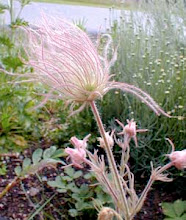
 These Minnesota DNR maps show the patterns of precipitation in inches during the week of 13-19 October and the percent of normal precipitation for the warm season so far -- 1 April through 19 Oct. As you can see, most of the eastern half of Nicollet County has received 80-90% of normal precipitation this summer.
These Minnesota DNR maps show the patterns of precipitation in inches during the week of 13-19 October and the percent of normal precipitation for the warm season so far -- 1 April through 19 Oct. As you can see, most of the eastern half of Nicollet County has received 80-90% of normal precipitation this summer. This graph from the National Climatic Data Center of the National Weather Service shows the variation of September temperatures across the US for the last 114 years! The red line smooths out the yearly values that, as you can see, are usually strongly variable from year to year. Note the slow warming since the mid-1960s but also a little cooling of the Septembers over most of the last few years.
This graph from the National Climatic Data Center of the National Weather Service shows the variation of September temperatures across the US for the last 114 years! The red line smooths out the yearly values that, as you can see, are usually strongly variable from year to year. Note the slow warming since the mid-1960s but also a little cooling of the Septembers over most of the last few years. This one, similar in style to the one above, shows the temperature fluctuations during the summer months, June-August, again for 114 years. You can again see the slow warming since the 1960s with a dip in the mid-1990s and again during the last few years. Most scientists believe these cooling periods are temporary and do not signal an end to the overall global warming trend.
This one, similar in style to the one above, shows the temperature fluctuations during the summer months, June-August, again for 114 years. You can again see the slow warming since the 1960s with a dip in the mid-1990s and again during the last few years. Most scientists believe these cooling periods are temporary and do not signal an end to the overall global warming trend.Climate Statistics for the Gustavus campus supplied by the weather station of the Department of Geography (http://homepages.gac.edu/~mbjellan/weather/).
Today, October 20
Avg. High Temperature: 61
Record High: 83 in 1950
Avg. Low Temperature: 36
Record Low: 11 in 1972
Record Rainfall : 1.26 in 1982
Record Snowfall : 0.00 on Missing
Sunrise: 07:37 AM
Moonrise: 10:36 AM
Sunset: 06:23 PM
Moonset: 07:27 PM
Monthly rain to date: 3.40
Year rain to date: 16.62
Average MRTD: 1.54 (MRTD = Monthly Rain to Date)
Average YTD: 26.55 (YTD = Year to Date)
+/- Month: +1.86
Water year rain to date: 16.62
+/- Year: -9.93#
Average YTD: 26.50
# Please note this deficit. We're nearly 10 inches below normal for the year even with the above normal precipitation for October thus far. This may help explain why the ponds in the Arb continue to look water deficient even with 1.86 inches of rainfall so far this October.
 This final series of maps gives a set of outlooks from the National Weather Service. They're not called "Forecasts" but rather the NWS's Climate Prediction Center uses the more general term "Outlooks" as they show the probabilities of temperature and precipitation for both November and the three month period of November 2008-January 2009. Look at the November temperature outlook map, upper left. The darker color shadings represent higher probabilities of warmer-than-normal temps, NOT higher values of temperature itself. So Arizona, for example, has a 40% chance of having warmer-than-normal temps and the lighter shaded Nebraska on the same map means that there's just a 33-40% chance of being warmer-than-normal -- less likely to be warm than Arizona. Similar interpretation of the blue shading, representing cooler-than-normal temps.
This final series of maps gives a set of outlooks from the National Weather Service. They're not called "Forecasts" but rather the NWS's Climate Prediction Center uses the more general term "Outlooks" as they show the probabilities of temperature and precipitation for both November and the three month period of November 2008-January 2009. Look at the November temperature outlook map, upper left. The darker color shadings represent higher probabilities of warmer-than-normal temps, NOT higher values of temperature itself. So Arizona, for example, has a 40% chance of having warmer-than-normal temps and the lighter shaded Nebraska on the same map means that there's just a 33-40% chance of being warmer-than-normal -- less likely to be warm than Arizona. Similar interpretation of the blue shading, representing cooler-than-normal temps.Similar evaluations for the precipitation probabilities. Looks like much of California, for example, has at least 40% chance of being wetter than normal for the November-January period. Again, the darker the shading, the greater the chance of being wetter than normal. Tan color means a probability of drier than normal climate.
Large sections of these maps, as you've noted by now, show no color at all, only the letters "EC" which means "Equal Chances" -- equal chances of it being either colder or warmer than usual, wetter or drier than usual.
These maps are usually issued on the Friday of each month closest to the 15th of the month.
-----------------
I'd like to end this post with a series of photographs from the Arb, taken this fall by Bob Dunlap, Arboretum Naturalist.
Bob Moline










